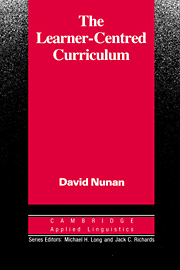Book contents
- Frontmatter
- Contents
- Series Editors' Preface
- Preface
- 1 Introduction
- 2 Curriculum Processes
- 3 Learner-Centred Curriculum Development
- 4 Pre-Course Planning Procedures
- 5 Planning Content
- 6 Methodology
- 7 Resources for a Learner-Centred Curriculum
- 8 Assessment and Evaluation
- 9 Evaluation and Professional Development
- 10 The Teacher as Curriculum Developer
- References
- Appendix
- Subject Index
- Author Index
7 - Resources for a Learner-Centred Curriculum
Published online by Cambridge University Press: 05 April 2013
- Frontmatter
- Contents
- Series Editors' Preface
- Preface
- 1 Introduction
- 2 Curriculum Processes
- 3 Learner-Centred Curriculum Development
- 4 Pre-Course Planning Procedures
- 5 Planning Content
- 6 Methodology
- 7 Resources for a Learner-Centred Curriculum
- 8 Assessment and Evaluation
- 9 Evaluation and Professional Development
- 10 The Teacher as Curriculum Developer
- References
- Appendix
- Subject Index
- Author Index
Summary
Introduction
At the classroom level, materials often seem more prominent than any other element in the curriculum. This no doubt is largely due to the fact that materials are the tangible manifestation of the curriculum in action. They are, in fact, omnipresent in the language classroom and it is difficult to imagine a class without books, pictures, filmstrips, realia, games and so on. Even the most austere classroom will have some sort of materials. The Community Language Learning class will have a tape recorder, while in the Silent Way class rods and charts will be the focus of attention. Inexperienced teachers very often look to materials first for assistance in planning their courses and also for teaching ideas. There is evidence that experienced teachers also look to materials when confronted with an unfamiliar class or learner type.
Materials are, in fact, an essential element within the curriculum, and do more than simply lubricate the wheels of learning. At their best, they provide concrete models of desirable classroom practice, they act as curriculum models, and at their very best they fulfil a teacher development role. Good materials also provide models for teachers to follow in developing their own materials.
Materials come in many shapes and formats. The most obvious distinction is between local materials produced by a teacher for her class, and those which are commercially produced. A survey conducted of several hundred teachers in one large ESL programme revealed that 73 per cent of teachers regularly used materials produced by themselves, while only 50 per cent used commercially-produced materials (Eltis and Low 1985).
- Type
- Chapter
- Information
- The Learner-Centred CurriculumA Study in Second Language Teaching, pp. 98 - 115Publisher: Cambridge University PressPrint publication year: 1988



